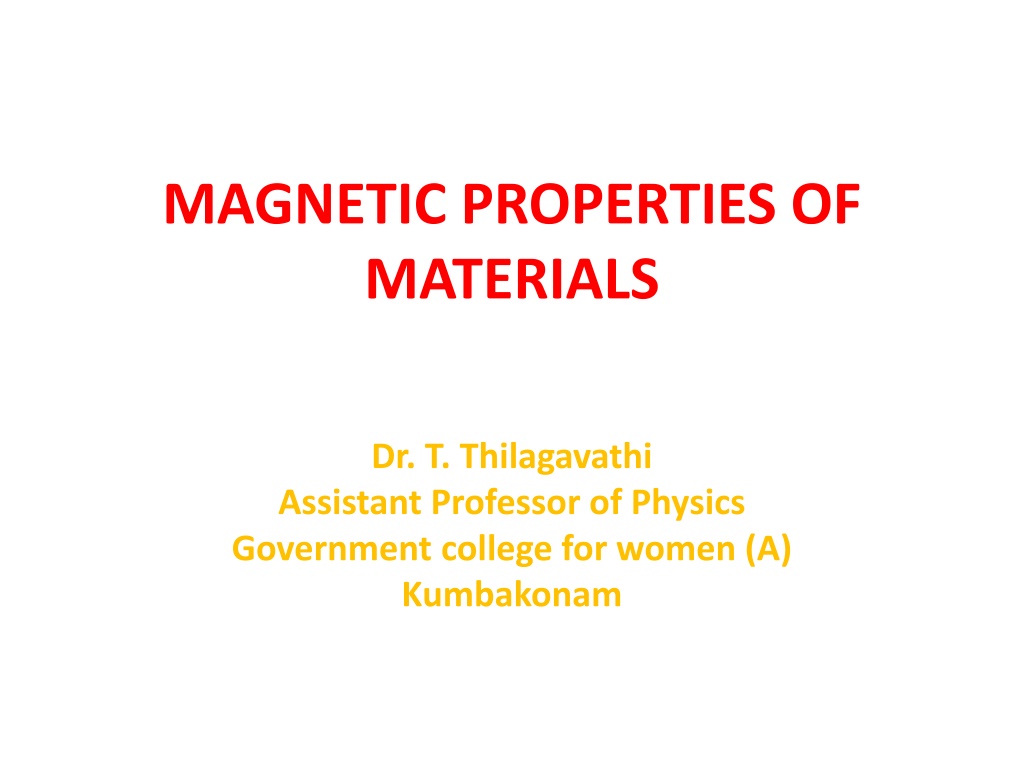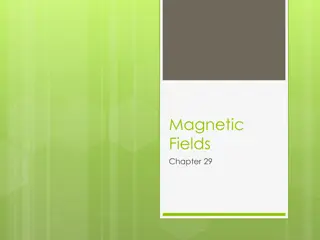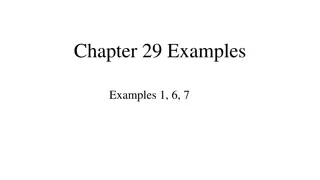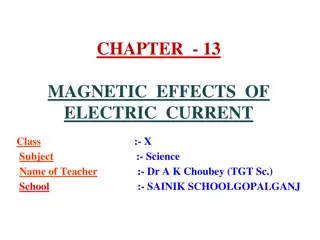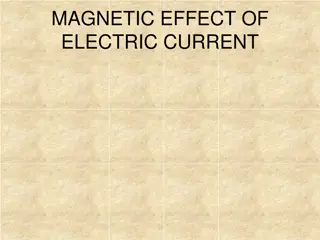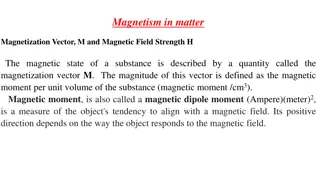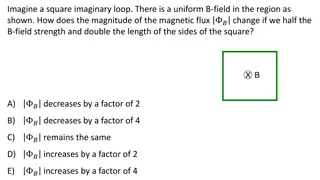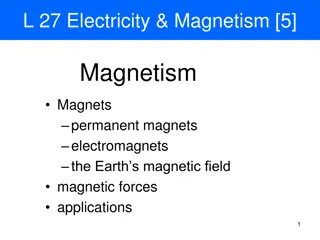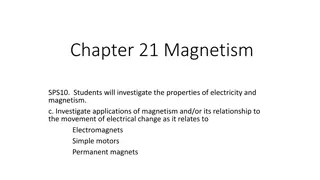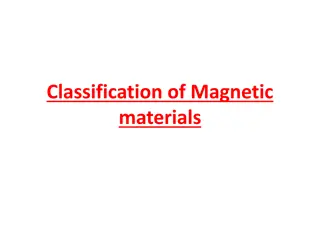Understanding Magnetic Properties of Materials in Physics
Explore the magnetic properties of materials through concepts such as basic magnetism, hysteresis, electromagnetic force, permeability, coercive force, and magnetic flux density. Delve into the study of magnetic fields, lines of force, and their applications in various engineering materials and magnetic applications. Enhance your knowledge of electromagnetism and its relevance in the field of physics.
Download Presentation

Please find below an Image/Link to download the presentation.
The content on the website is provided AS IS for your information and personal use only. It may not be sold, licensed, or shared on other websites without obtaining consent from the author. Download presentation by click this link. If you encounter any issues during the download, it is possible that the publisher has removed the file from their server.
E N D
Presentation Transcript
MAGNETIC PROPERTIES OF MATERIALS Dr. T. Thilagavathi Assistant Professor of Physics Government college for women (A) Kumbakonam
Unit II Basic magnetism Dia, Para, Ferro magnetic materials Hysteresis B-H curve using Ballistic Galvanometer Energy loss due hysteresis and its importance. definitions Electron theory of
Electricity and Magnetism Electromagnetism is a branch of physics involving the study of the electromagnetic force A type of physical interaction that occurs between electrically charged particles.
Magnetic properties of material The magnetic properties of a material are those which determine the ability of material to be suitable for a particular magnetic Application. Some of the typical magnetic properties of engineering materials are listed below- Permeability. Retentively or Magnetic Hysteresis. Coercive force.
Magnetic Field ( ) Magnetic defined as the space around the magnet (or) the current conductor magnetic effect is felt. field is carrying where the
Magnetic lines of Forces Magnetic field consists of a number of imaginary lines of magnetic forces. These lines of forces travel externally from north pole to south pole. The magnetic lines of force is defined as the continuous curve in a magnetic field. The tangent drawn at any point on the curve gives the direction of the resultant magnetic intensity at that point.
Magnetic Flux ( ) ( ) The total number of magntic lines of force passing surface is known as magnetic flux. It is represented by the symbol ( ) Its unit is weber. through a
Magnetic flux density (or) Magnetic induction (B) It is defined as the number of magnetic lines of force ( ) passing perpendicularly through a unit area of a cross section (A). It is denoted by the symbol (B) and its unit is Weber/m2 (or) tesla. Magnetic flux density is given by B=fi/A weber/m2 It is also equal to the magnetic force experienced by a unit north pole placed in that magnetic filed.
Magnetic Dipole ( ) Any two equal and opposite magnetic poles seperated by a small distance (d) constitute a magnetic dipole (or) A system having two opposite magnetic poles seperated by a distance (d) is called as a magnetic dipole.
Magnetic dipole moment (M) A system having two opposite magnetic poles seperated by distance (d) is called as a magnetic dipole. If (m) is the magnetic pole strength and (l) is the length of the magnet, its dipole moment is given by the product (ml). It is expressed in Am2. It is a vector quantity Dipole moment M = ml
Bohr Magneton The orbital magnetic moment and the spin magnetic moment of an electron in an atom can be expressed in terms of atomic unit of magnetic moment called Bohr magnetron. One Bohr Magnetron e /2m (or) b=eh/4 m Where = h/2 B = 9.27 * 10-24Am2
Magnetic field intensity (or) Magnetic field strength (H) It is defined as the force experienced by a unit north pole placed at the given point in a magnetic field. It is denoted by H and its unit is Am-1. Magnetic field intensity is the ratio between the magnetic induction (B) and permeability ( ) of the medium in which the magnetic field exists. H = B/ Am-1
Magnetization (or) Intensity of magnetisation (I) The term magnetisation means the process of converting non-magnetic material into magnetic material. It is also defined as the magnetic moment per unit volume. It is expressed in I=M/V Am-1
Magnetic Susceptibiltiy (m ) Magnetic susceptibility is the ratio between the intensity of magnetisation and the magnetic field intensity (H). It has no unit. Thus it measures the amount of magnetisation produced in the sample during the application of magnetic field m = I/H
Magnetic Permeability ( ) Magnetic magnetic lines of force penetrating through the material. It is defined as the ratio between the magnetic flux density (B) and the magnetic field intensity (H). It is expressed in Hentry m-1. = B/H Henry m-1 = o r o is the permeability of air medium 4 *10-7 Henry m-1) r is the relative permeability permeability is the measure of
Relative permeability (r) It is the ratio between the permeability of the medium to the permeability of free space. It has no unit. r = / o
